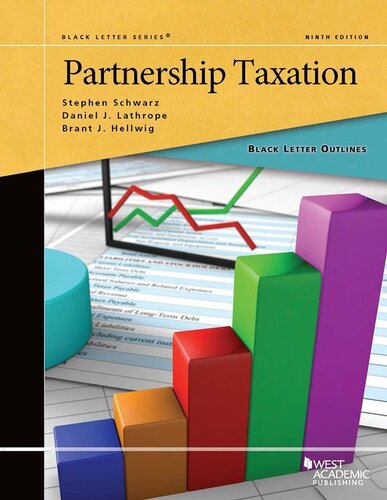Black Letter Outline on Partnership Taxation Black Letter Outlines Stephen 1st editon by Schwarz Stephen, Lathrope Daniel, Hellwig Brant 1634607074 9781634607070
$50.00 Original price was: $50.00.$25.00Current price is: $25.00.
Black Letter Outline on Partnership Taxation Black Letter Outlines Stephen 1st editon by Schwarz Stephen, Lathrope Daniel, Hellwig Brant – Ebook PDF Instant Download/Delivery: 1634607074, 9781634607070
Full download Black Letter Outline on Partnership Taxation Black Letter Outlines Stephen 1st editon after payment
Product details:
ISBN 10: 1634607074
ISBN 13: 9781634607070
Author: Schwarz,Stephen; Lathrope,Daniel; Hellwig,Brant
This comprehensive and clearly written text is designed to help students recognize and understand the basic principles and issues covered in law school courses in partnership or pass-through entity taxation at both the J.D. and LL.M. levels. It explains all the fundamental concepts and transactions affecting partnerships, limited liability companies, and S corporations and includes numerous illustrative examples, self-test questions with answers, and sample exam questions.
Black Letter Outline on Partnership Taxation Black Letter Outlines Stephen 1st Table of contents:
Chapter I. Introduction
A. Forms of Business Organizations
1. Sole Proprietorship
2. Corporation
3. Partnership
a. General Partnership
b. Limited Partnership
c. Limited Liability Partnership
d. Publicly Traded Partnership
e. Joint Venture
4. Limited Liability Company
5. Demography
B. Conceptual Taxation Models
1. Aggregate Concept
2. Entity Concept
3. Hybrid Concepts
C. Overview of Taxing Regimes Under the Code
1. Subchapter C
2. Subchapter K
3. Subchapter S
4. Specialized Tax Regimes
D. Influential Policies
1. The Double Tax
2. Rate Structure
3. Preferential Rates on Capital Gains and Qualified Dividends
4. Nonrecognition of Gain or Loss
E. Pervasive Judicial Doctrines
1. Substance over Form
2. Step Transactions
a. The Binding Commitment Test
b. The End Result Test
c. The Interdependence Test
d. Application by Courts and IRS
3. Business Purpose
4. Sham Transaction
5. Economic Substance
6. Codification of the Economic Substance Doctrine
Chapter II. Classification
A. Introduction
1. Impact of Classification
2. The Role of State Law
3. Principal Classification Issues
B. Existence of a Separate Entity
1. In General
2. Joint Profit Motive
3. Separate Entity vs. Co-ownership of Property
a. In General
b. Fractional Interests in Rental Real Property
c. Section 761(a) Election
d. Section 761(f): Husband-Wife Qualified Joint Venture
4. Separate Entity vs. Expense Sharing, Employment, Loan, and Other Relationships
C. Classification of Business Entities
1. Introduction
2. The “Check-the-Box” Classification Regulations
a. Introduction
b. Entities with Two or More Members
c. Business Entities with One Owner
d. Series LLCs
e. Entity Owned as Community Property
f. Foreign Entities
g. Election
h. Existing Entities
3. Publicly Traded Partnerships
4. Trusts
D. Choice of Entity Considerations
1. Publicly Traded Businesses
2. Closely Held Businesses
a. In General
b. C Corporations
c. S Corporations
d. Limited Liability Companies
e. Limited Partnerships
f. Converting from Corporation to Pass-Through Entity
g. State Tax Considerations
E. Review Questions
Chapter III. Formation of a Partnership
A. Introduction
B. Contributions of Property
1. General Rules
2. Related Issues
a. Recapture Provisions
b. Installment Obligations
c. Investment Partnerships
d. Noncompensatory Options
1) In General
2) Noncompensatory Option Defined
3) Applicability of Section 721 to Noncompensatory Options
e. Debt-for-Equity Exchanges
3. Basis and Holding Period
a. “Outside” and “Inside” Bases
b. Holding Period
C. Treatment of Liabilities
1. Impact on Partner’s Outside Basis
a. Introduction
b. Classification of Liabilities and Partners’ Shares of Partnership Liabilities
c. Economic Risk of Loss
2. Contributions of Property Encumbered by Recourse Liabilities
D. Organization and Syndication Expenses
1. General Rule
2. Deduction and Amortization of Organization Expenses
3. Syndication Expenses
E. Review Questions
Chapter IV. Partnership Operations: General Rules
A. Aggregate and Entity Theories of Partnership Taxation
B. Taxing Partnership Operations
1. Partnership Level Determination of Tax Results
a. Partnership Accounting Method
b. Partnership Taxable Year
1) Mechanical Rules
2) Business Purpose
3) Fiscal Year Election
c. Partnership Taxable Income
1) In General
2) Separately Stated Items
d. Tax Elections
2. Tax Consequences to the Partners
a. Timing and Character of Pass Through Items
b. Basis Adjustments
3. Limitations on Partnership Losses
a. Basis Limitation
b. At-Risk Limitation
1) Introduction
2) At-Risk Amount: In General
3) Qualified Nonrecourse Financing
4) Other Nonrecourse Debt
5) Limited Partner Guarantees and Other Partner Obligations
6) Adjustments to Amount at Risk and Carryover of Suspended Losses
c. Passive Activity Loss Limitation
1) Introduction
2) Material Participation
3) Definition of “Activity”
4) Later Use of Suspended Losses
C. Review Questions
Chapter V. Partnership Allocations: § 704(b)
A. Partnership Allocations: Substantial Economic Effect
1. Introduction
2. Special Allocations
a. Introduction
b. Partnership Accounting: The Basics
c. Economic Effect
1) Introduction
2) Basic Test: “The Big Three”
3) Alternate Test for Economic Effect
4) Economic Effect Equivalence
d. Substantiality
1) Introduction
2) General Rule for Substantiality
3) Shifting and Transitory Allocations
a) Shifting Allocations
b) Transitory Allocations
4) The Baseline for Testing Substantiality
5) Presumption Validating “Gain Chargeback” Provisions
e. Partner’s Interest in the Partnership
f. Allocations of Depreciation Recapture
g. Allocations of Tax Credits
h. Target Allocations
B. Allocations Attributable to Nonrecourse Liabilities
1. Introduction
2. Partnership Minimum Gain
3. Nonrecourse Deductions
4. Safe Harbor Test for Respecting Allocations of Nonrecourse Deductions
5. Minimum Gain Chargeback Requirement
6. Refinancings and Distributions
C. Review Questions
Chapter VI. Partnership Allocations: Income-Shifting Safeguards
A. Allocations with Respect to Contributed Property
1. § 704(c) Allocations: General Principles
2. § 704(c) Allocation Methods
a. In General
b. The Ceiling Rule
c. Sales and Exchanges of Contributed Property
1) Traditional Method
2) Traditional Method with Curative Allocations
3) Remedial Method
d. Depreciation and Depletion
1) Traditional Method
2) Traditional Method with Curative Allocations
3) Remedial Method
3. Application of § 704(c)(1)(A) Principles to the Entry of a New Partner
a. Allocation of Preexisting Gains and Losses: In General
b. Methods of Allocating Preexisting Gains and Losses
1) Allocation in Partnership Agreement
2) Revaluation and Restatement of Capital Accounts
4. Distributions of Contributed Property Within Seven Years of Contribution
5. Characterization of Gain or Loss upon Partnership’s Disposition of Contributed Property
a. Unrealized Receivables
b. Inventory Items
c. Capital Loss Property
d. Depreciation Recapture
6. Anti-Abuse Rule for Loss Property
B. Partnership Interests Created by Gift or Acquired by Purchase from Family Member
1. Purpose of § 704(e)
2. Definitions of Partnership and Partner
3. Determination of Distributive Share of Donee
C. Allocations Where Partners’ Interests Vary During the Year
1. Introduction
2. Determination of Distributive Shares
a. Permissible Allocation Methods
b. Services Partnerships
c. Allocation of Extraordinary Items
3. Distributive Shares of Allocable Cash Basis Items: § 706(d)(2)
a. Determination on Per-Day, Per-Partner Basis
b. Items Attributable to Periods Not Within Taxable Year
4. Tiered Partnerships
D. Review Questions
Chapter VII. Partnership Liabilities
A. Introduction
B. Economic Risk of Loss
1. General Rules
2. The Relationship Between Economic Risk of Loss and Economic Effect
3. Proposed Regulations
C. Nonrecourse Liabilities
1. General Rules
2. Proposed Regulations
D. Special Rules
1. Part Recourse and Part Nonrecourse Liabilities
2. Tiered Partnerships
E. Review Questions
Chapter VIII. Compensating the Service Partner
A. Payments for Services: General Rules
1. Services Rendered in a Nonpartner Capacity: § 707(a)(1)
a. General Rules
b. Tax Stakes
c. Determination of Partner or Nonpartner Status
2. Disguised Payments for Services: § 707(a)(2)(A)
a. Tax Planning Agenda
b. Recharacterization Under § 707(a)(2)(A)
c. § 707(a)(2)(A) Factors
d. Proposed Regulations
1) Focus on Entrepreneurial Risk
2) Application to Management Fee Waivers
3) Breadth of Proposed Regulations
3. Guaranteed Payments for Services: § 707(c)
a. Guaranteed Payment Defined
b. Tax Consequences to the Service Partner
c. Tax Consequences to the Partnership
d. Treatment Under Other Code Provisions
e. Calculation of Guaranteed Payments
1) Current Approach of IRS
2) Proposed Regulations
B. Partnership Equity Issued in Exchange for Services
1. Introduction
2. Capital Interest vs. Profits Interest
3. Receipt of a Capital Interest for Services
a. Tax Consequences to the Service Partner
b. Tax Consequences to the Partnership
1) Business Expense Deduction to the Partnership
2) Taxable Event to Partnership
4. Receipt of a Profits Interest for Services
a. Tax Consequences to the Service Partner
1) Historical Approach
2) The Diamond Case
3) Safe Harbor: Revenue Procedure 93–27
4) Timing Issues: Revenue Procedure 2001–43
b. Tax Consequences to the Partnership
5. Proposed Regulations
C. Policy Issues: Carried Interests
1. Tax Advantages of Carried Interests
2. Criticisms of Current Tax Treatment
D. Review Questions
Chapter IX. Property Transactions Between Partnerships and Partners
A. Introduction
B. § 707(a)(1) Property Transactions
1. In General
2. Disguised Payments for the Use of Property: § 707(a)(2)(A)
a. Tax Planning Agenda
b. Recharacterization Under § 707(a)(2)(A)
c. § 707(a)(2)(A) Factors
C. Guaranteed Payments: § 707(c)
D. Sales and Exchanges of Property Between Partners and Partnerships: General Rules
E. Disguised Sales Between Partners and Partnerships: § 707(a)(2)(B)
1. Key Factors
2. Debt-Financed Distributions
F. Review Questions
Chapter X. Sales and Exchanges of Partnership Interests
A. Introduction
B. Tax Consequences to the Selling Partner
1. Computation of Gain or Loss
a. Amount Realized
b. Adjusted Basis of Partnership Interest
2. Characterization of Gain or Loss
a. General Rule: § 741
b. Definition of § 751 Assets
1) Unrealized Receivables
2) Inventory Items
c. Computation of § 751 Gain or Loss
d. Capital Gains Look-Through Rules
e. Holding Period
3. Related Issues
a. Installment Sale of a Partnership Interest
b. Exchange or Conversion of Partnership Interests
1) Exchanges of Partnership Interests
2) Conversions of Partnership Interests
3) Conversions into LLC or LLP Interests
C. Tax Consequences to the Buying Partner
1. Introduction
2. Operation of § 743(b)
a. Requirement of § 754 Election or Substantial Built-in Loss
1) General Rules
2) Special Rules
b. Adjustments to Inside Basis Under § 743(b)
1) The Overall § 743(b) Adjustment
2) Allocation of the Adjustment
c. Effect of § 743(b) Adjustment
d. Contributed Property with a Built-in Loss
D. Review Questions
Chapter XI. Operating Distributions
A. Consequences to the Partner
1. Cash Distributions
a. In General
b. Distributions of Marketable Securities
1) General Rule
2) Reduction for Distributee’s Share of Partnership Net Gain
3) Exceptions
2. Property Distributions
a. Recognition of Gain or Loss
b. Basis Consequences
1) General Rule: Transferred Basis
2) Basis Limitation
3) Allocation of Basis
4) Holding Period
c. § 732(d) Election
3. Dispositions of Distributed Property
a. General Rules: § 735
b. Depreciation Recapture
B. Consequences to the Partnership
1. Nonrecognition of Gain or Loss
2. Impact on Inside Basis
a. General Rule: No Adjustment to Inside Basis
b. § 734(b) Adjustment
c. Allocation of Basis Adjustment
3. Adjustments to Capital Accounts
C. Mixing Bowl Transactions
1. Introduction
2. Distributions of Contributed Property to Another Partner
a. The Attempted Strategy
b. General Rule of § 704(c)(1)(B)
c. Exceptions
3. Distributions of Other Property to the Contributing Partner
a. The Attempted Strategy
b. General Rule of § 737
c. Exceptions
D. Distributions Which Shift the Partners’ Interests in § 751 Assets: § 751(b)
1. Purpose and Scope of § 751(b)
2. § 751(b) Assets
3. Operation of § 751(b)
4. Criticisms of § 751(b)
5. Proposed Regulations
E. Review Questions
Chapter XII. Liquidating Distributions and Terminations
A. Liquidation of a Partner’s Interest
1. Introduction
2. § 736(b) Payments
a. Tax Consequences of § 736(b) Payments to the Partner
1) Recognition of Gain
2) Recognition of Loss
3) Basis of Distributed Property: In General
4) Allocation of Basis
5) Holding Period
b. Tax Consequences of § 736(b) Payments to the Partnership
1) General Rules
2) § 754 Election
c. Interaction of § 736 and § 751(b)
3. § 736(a) Payments
a. Definition of § 736(a) Payments
b. Tax Treatment of § 736(a) Payments
c. Timing of § 736(a) Payments: In General
d. Special Treatment for Partnership Goodwill
4. Allocation and Timing of § 736 Installment Payments
a. Allocation
b. Timing
5. Liquidation vs. Sale
a. In General
b. Abandonment of a Partnership Interest
B. Liquidation of the Entire Partnership
1. Voluntary Liquidation
a. In General
b. Incorporation of a Partnership
c. Partnership Mergers and Divisions
1) Merger or Consolidation
2) Divisions
2. Termination Forced by Statute
a. Sale or Exchange of 50% or More of Total Interests in Capital or Profits: § 708(b)(1)(B)
b. Effect of Termination
C. Review Questions
Chapter XIII. Death of a Partner
A. Introduction
B. The Deceased Partner’s Distributive Share in the Year of Death
C. Estate Tax, Income in Respect of a Decedent, and Basis Consequences
1. Federal Estate Tax
2. Income in Respect of a Decedent (“IRD”)
a. In General
b. Distributive Share in Year of Death
c. Income in Respect of a Decedent in a Sale at Death or Continuing Interest
d. Income in Respect of a Decedent in a Liquidation of a Partnership Interest
3. Outside and Inside Basis
D. Review Questions
Chapter XIV. Partnership Anti-Abuse Rule
A. Introduction
B. Abuse of Subchapter K Rule
1. In General
a. “Common Law” Requirements of Subchapter K
b. Administrative Convenience Exception
c. Impermissible Tax Reduction Purpose
2. Facts and Circumstances Analysis
a. In General
b. Specific Factors
c. Examples
3. Commissioner’s Power to Recast Transactions
C. Abuse of Partnership Entity
D. Review Questions
Chapter XV. S Corporations
A. Introduction
B. Eligibility for S Corporation Status
1. Ineligible Corporations and Subsidiaries
a. In General
b. Wholly Owned Subsidiaries
2. 100-Shareholder Limit
3. Restrictions on Types of Shareholders
a. In General
b. Nonresident Alien Restriction
c. Trusts as Eligible Shareholders
d. Qualified Subchapter S Trusts
e. Electing Small Business Trusts
4. One-Class-of-Stock Requirement
a. In General
b. Buy-Sell and Redemption Agreements
c. Obligations Treated as Equity Under General Principles
d. Straight Debt Safe Harbor
1) Background
2) Straight Debt Defined
3) Treatment of Straight Debt for Other Purposes
4) Treatment of Converted C Corporation Debt
C. Election, Revocation, and Termination of Subchapter S Status
1. Electing S Corporation Status
a. In General
b. Timing and Effective Date of Election
2. Revocation and Termination of S Corporation Status
a. Revocation
b. Termination
1) Ceasing to Be a Small Business Corporation
2) Passive Income Limitation for Certain S Corporations
c. S Termination Year
d. Inadvertent Terminations
D. Tax Treatment of S Corporation Shareholders
1. Introduction
2. Corporate Level Determination of Tax Results
a. Accounting Method
b. Taxable Year
1) In General
2) Natural Business Year
3) § 444 Fiscal Year Election
c. S Corporation Taxable Income
1) In General
2) Separately Stated Items
3) Charitable Contributions
4) No Dividends Received Deduction
5) Organizational Expenses
d. Tax Elections
3. Tax Consequences to Shareholders
a. Timing and Character of Pass-Through Items
b. Determining Each Shareholder’s Pro Rata Share
1) In General
2) Special Rule for Termination of a Shareholder’s Interest
3) Special Rule for a Family Group
c. Limitations on Losses
1) § 1366(d) Basis Limit
2) Basis of Indebtedness of S Corporation to a Shareholder
3) Basis Credit for Shareholder Guarantee of S Corporation Debt
4) No Basis Credit for Entity Debt
5) Use of Suspended Losses After Termination of S Corporation Status
6) Related Provisions
d. Basis Adjustments
e. Sale of S Corporation Stock
E. Distributions to Shareholders
1. S Corporations Without E & P
2. S Corporations with E & P
a. In General
b. The Accumulated Adjustments Account
3. Distributions of Property
4. Ordering of Basis Adjustments
5. Distributions Following Termination of S Corporation Status
F. Taxation of the S Corporation
1. § 1374 Tax on Built-In Gains
a. Policy of Built-In Gains Tax
b. Operation of § 1374
c. Treatment of Substituted Basis Properties
d. Installment Sales and § 1374
2. § 1375 Tax on Excessive Passive Investment Income
G. Coordination of Subchapter S with Subchapter C and Other Tax Provisions
1. Subchapter C
2. Other Tax Provisions
3. Employment Taxes
a. Background
b. S Corporation Tax Avoidance Strategy
4. Net Investment Income Tax
a. Background
b. Application to S Corporation Shareholders
c. Sale of S Corporation Stock
H. Review Questions
Appendix A. Answers to Review Questions
Appendix B. Practice Examination
Appendix C. Glossary
TABLE OF CASES
TABLE OF INTERNAL REVENUE CODE SECTIONS
TABLE OF TREASURY REGULATIONS
TABLE OF REVENUE RULINGS AND PROCEDURES
INDEX
People also search for Black Letter Outline on Partnership Taxation Black Letter Outlines Stephen 1st :
partnership taxation outline
partnership tax outline
black letter outlines
partnership tax outline nyu
Tags:
Schwarz Stephen,Lathrope Daniel,Hellwig Brant,Partnership Taxation,Black Letter,Outlines Stephen
You may also like…
Science Fiction - Other Sci-Fi
Romance - Paranormal Romance
Politics & Philosophy - Social Sciences
Romance - Paranormal Romance
Uncategorized
Romance - Paranormal Romance
Dark Lover Black Dagger Brotherhood 01 1st Edition by JR Ward ISBN 0451216954 9780451216953
Romance - Paranormal Romance












